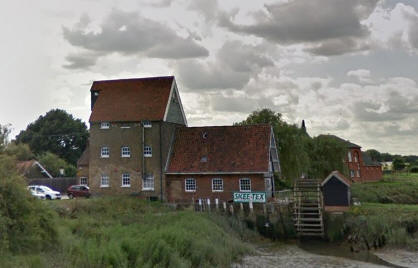Mills driven by Water
Water driven mills harnesses the power of water to drive wheels that would grind flour.
Corn would arrive at the mill either by barge or by horse and cart.
A hoist was used to lift the corn to the upper story once at the top of the mill the corn was emptied into bins and then released into a series of hoppers to the ground floor where it would be fed into the grinding stone.
Once ground it would then go through a series of sieves which separated it into waste and the various grades of flour.
Eastern Essex had two very wide rivers not suitable for a watermill.
The creeks were slow flowing and mostly very marshy so during the early 1800's this area not considered suitable for watermills hence windmills tended to predominate.
Watermill
Blue Mills at Woodham Walter was the site for a watermill which was built in 1810 using large stones and two pairs of mill stones quarried from Paris, France.
The mill harnesses water from a mill pond and stream.
A windmill was added later to work in tandem and offer the miller the use of wind or water depending on the best available.
Tidal Mill
One tidal mill survives at Battlesbridge.

Courtesy of Google Maps
The mill is in private ownership and so the best viewpoint is the bridge over the River which gives good views.
The mill harnesses to tide at the point where the Crouch changes from Salt to freshwater .This was the last navigable point for the larger Thames Barges who would have carried corn to the mill and flour to the big London market.
Battlesbridge tide mill was built in the 1830's and has been listed as a Grade II listed building.
The main building is of three storeys with a loft and a weatherboarded lucam, built of yellow stock brick with a clay tile roof. A single storey red brick and weatherboard range with a pantiled roof extends to the river bank and dam wall. The mill has been converted for business use,
The adjoining dam wall and tide gates are sited alongside the mill.

